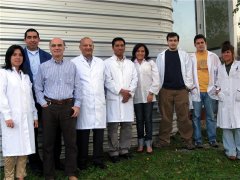Feb 17 2009
The hydrogels are polymers in the shape of a net. These hydrogels can swell up — by absorption — but cannot be dissolved in a liquid. This type of polymers has many and very diverse applications. For example, they can be used to make artificial muscle or for capturing heavy metals in waste water.
 Leyre Pérez, Guillermo Guerrero, Carlos Cesteros, Issa Katime, José Luis Gadea, Diana C. Ospina, Alejandro Arzac, Alejandro Arredondo and Maite Arteche (photograph: Lucía Álvarez).
Leyre Pérez, Guillermo Guerrero, Carlos Cesteros, Issa Katime, José Luis Gadea, Diana C. Ospina, Alejandro Arzac, Alejandro Arredondo and Maite Arteche (photograph: Lucía Álvarez).
The New Materials and Supramolecular Spectroscopy research team at the Department of Physical Chemistry in the Faculty of Sciences and Technology of the UPV/EHU is a pioneering one in the investigation of hydrogels and is led by Dr. Issa A. Katime, author of the only book published in Spanish on the topic. At present, they are using hydrogels to release pharmaceutical drugs in a controlled manner, for example, with cancer patients. Their goal was to design a particle capable of detecting where the cancer is. To this end, intelligent hydrogels capable of detecting changes in pH were developed — while blood generally has a pH of 7.4, in a zone where a cancer is located it drops to 4.7-5.2. In order to achieve this capability, these hydrogels are functionalised with folic acid, which has the ability to detect and to “trick” cancer cells, in such a way that these permit penetration of their membranes: under these conditions the hydrogel acts like a “Trojan horse”. Once in the cell interior, the change in pH favours the swelling of the nano-hydrogel and, thus, the release of the pharmaceutical drug.
But known hydrogels present a problem in their application with patients: their molecular size. The most effective manner to administer a pharmaceutical drug is intravenously — it gets to all parts in a very short time —, but very large molecules cannot be injected because they may cause obstruction or problems on the organism such as, for example, angina pectoris and even heart attack. The essential condition for their use in humans is that these particles have to be sufficiently small so as not to obstruct the veins and arteries and, besides, not be detected by the white corpuscles — otherwise the latter will attack the former and cause them to enlarge, giving rise to the previously mentioned problem. Thus, if these particles are small enough to pass through the membrane of the kidney, in the case of not detecting any cancer cells, they can be excreted in the urine.
The problem of size
The use of nanoparticles for these ends holds a number of difficulties: interweaving them in a controlled manner in order to create the nano-hydrogels; the spaces created within the structure of the net having the necessary size to transport the pharmaceutical drug; and all the particles having a similar size.
What happens is, on synthesising polymers, particles of very different sizes are obtained. If they are to be injected into the human body, these particles cannot be much greater than 15-30 nanometres. To this end, the research team perfected a technique that not only enabled the obtaining of nanoparticles, but also that they all were of similar size.
The final design of the nanoparticles was a success. Currently these are undergoing “in vivo” trials with research teams led by Dr. José María Teijón, Professor at the Faculty of Medicine at the Complutense University in Madrid and Dr. Antonio Quintana, Professor at the Faculty of Medicine at the UPV/EHU.
But these intelligent nano-hydrogels are not only useful for combating cancer. The application of nano-hydrogels with anti-tubercular pharmaceutical drugs is currently being investigated. Today, the most effective anti-tubercular drugs have to be injected several times daily, a problem in areas with poor access to health centres, as in developing countries.
This research team is designing a system with nano-hydrogels that contains a mixture of anti-tubercular pharmaceutical drugs and which release this medication in a controlled and constant manner over long periods of time. But, in this case, the hydrogel is charged with more than one substance, and it is consequently more difficult to control the speed and concentration with which the pharmaceutical drug is released. This will oblige the team to modify the structure of the hydrogel and adapt it to suit the need of the case in hand.